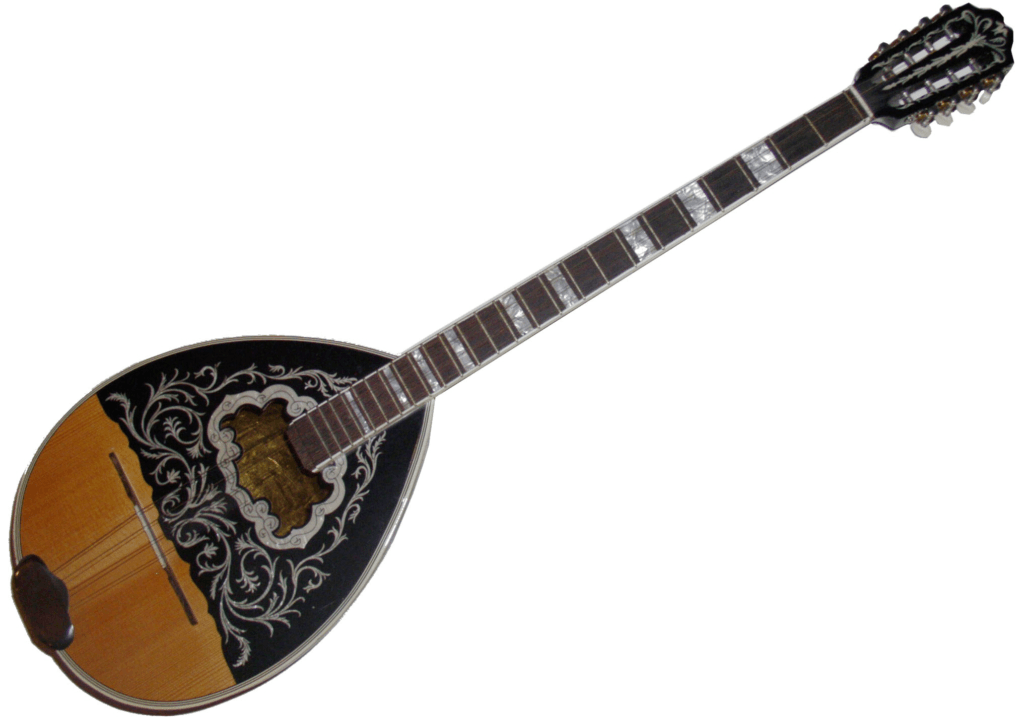The bouzouki is a mandolin-like stringed instrument that is widely considered to be the national instrument of Greece. With its distinctive egg-shaped body, long neck, and characteristic sound, the bouzouki has become a prominent feature in various genres of Greek music, including rebetiko, laïka, nisiotika, and skatz.
History and Culture of the Bouzouki
The bouzouki’s origins can be traced back to the 19th century, drawing inspiration from instruments like the bağlama and oud, which originated in the Middle East. Brought to Greece by Greek immigrants from Asia Minor, the bouzouki gradually assimilated into local musical traditions, developing its own unique identity over time. By the early 20th century, the bouzouki had risen to national instrument status, coinciding with the popularity of rebetiko music. Rebetiko, a genre that expressed the hardships and hopes of Greece’s working class and immigrants, found in the bouzouki an instrument capable of conveying these emotions with great intensity.

Where is the Bouzouki Played?
The bouzouki is a ubiquitous sound throughout Greece. It can be heard in tavernas, cafes, on the streets, and at concerts. It is also a popular choice for weddings, festivals, and other special occasions. In recent years, the bouzouki has expanded its reach into genres like jazz, rock, and world music.
Bouzouki Construction
Traditionally, the bouzouki is crafted using wood carving techniques. The body is typically made from mulberry or pearwood, while the neck is crafted from maple or mahogany. The fretboard is usually made from ebony or rosewood, and the frets are either metal or gut. Bouzouki strings can be made of steel or nylon.
The Bouzouki’s Sound
The bouzouki’s sound is often described as bright, treble-heavy, and metallic. It can be played with a plectrum or fingers and produces a wide range of tones. The bouzouki is versatile enough to render both melancholic and joyful melodies, and is renowned for its ability to express the emotional depth of Greek music.
Bouzouki Types
There are three main types of bouzouki:
- Mikro Bouzouki: The smallest and most common type of bouzouki, it is prominently featured in traditional Greek music genres like rebetiko, laïka, and nisiotika.
- Tsestos Bouzouki: Slightly larger than the mikro bouzouki, it is commonly used in skatz music.
- Bouzouki Mandola: The largest type of bouzouki, it is typically used in classical Greek music.
Famous Bouzouki Players
Greece boasts a rich tradition of bouzouki virtuosos. Some of the most celebrated bouzouki players include:
- Manolis Chiotis: A pioneer of rebetiko music, he is revered as the “Father of the Bouzouki.”
- Vasilis Tsitsanis: A prominent composer and performer of rebetiko and laïka music.
- Babis Tsimbidis: A leading figure in laïka music, he is known as the “King of the Bouzouki.”
- Manos Xatzidakis: A renowned composer of modern Greek music, he incorporated the bouzouki into classical compositions.
- Giorgos Dalaras: A prominent laïka and pop music artist, he played a significant role in popularizing the bouzouki.
The bouzouki stands as a cornerstone of Greek cultural identity and musical heritage. Its powerful sound, expressive capabilities, and versatility have made it a beloved instrument that embodies the soul of the Greek people. If you ever find yourself visiting Greece, don’t miss the opportunity to experience the captivating sounds of this remarkable instrument in person. For those aspiring to learn the bouzouki, Greece offers a wealth of talented instructors and music schools. While mastering the bouzouki presents a challenge, the journey of exploring its rich history and culture is an invaluable experience for anyone seeking to connect with the heart of Greek music.
Here’s a breakdown of the key differences between the oud and the bouzouki:
Origin and History:
Oud: The oud has a much older history, dating back thousands of years to Mesopotamia and the Middle East. It is considered the ancestor of many stringed instruments, including the lute.
Bouzouki: The bouzouki emerged in the 19th century, likely influenced by instruments like the oud and bağlama brought to Greece by immigrants from Asia Minor.
Body Shape and Construction:
Oud: The oud has a more pear-shaped body with a rounded bottom and a shorter neck. It is traditionally made from woods like rosewood or maple.
Bouzouki: The bouzouki has a more pronounced egg-shaped body with a flatter bottom and a longer neck. It is typically made from woods like mulberry or pearwood for the body and maple or mahogany for the neck.
Frets:
Oud: The oud does not have frets on the fingerboard. Notes are achieved by precisely positioning the fingers on the strings.
Bouzouki: The bouzouki has frets running along the fingerboard, similar to a guitar, making it easier to play specific notes.
Playing Technique:
Oud: The oud is traditionally played with a plectrum (pick), although fingers can also be used. The fretless design allows for more nuanced ornamentation and microtones.
Bouzouki: The bouzouki can be played with a plectrum or fingers. The frets make it easier to play chords and melodies cleanly.
Sound:
Oud: The oud has a warmer, mellower, and more rounded sound compared to the bouzouki. It’s known for its rich and complex tonal range.
Bouzouki: The bouzouki has a brighter, sharper, and more metallic sound. It projects well and cuts through in ensembles.
Tuning:
Oud: The oud has various tuning variations depending on the region and musical style.
Bouzouki: The bouzouki typically has a standard tuning with variations depending on the type of bouzouki (mikro, tsestos, or bouzouki mandola).
Areas of Use:
Oud: The oud is widely used in Middle Eastern and Mediterranean classical music traditions, as well as folk music, jazz, and fusion genres.
Bouzouki: The bouzouki is a prominent instrument in Greek music, particularly rebetiko, laïka, nisiotika, and skatz. It’s also finding its way into other genres like jazz, rock, and world music.




